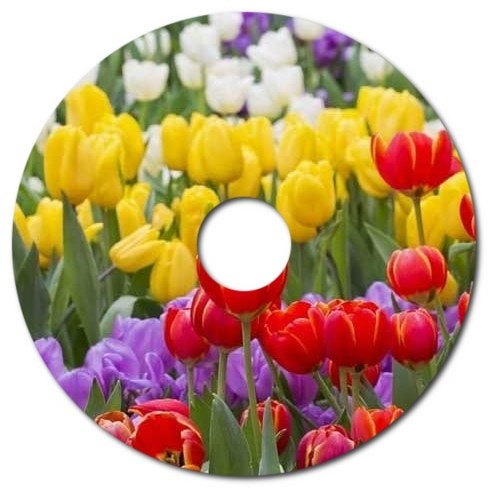Flower bulbs are divided into spring flowering fall bulbs and summer flowering summer bulbs. Fall bulbs may differ in planting times depending on the climatic conditions where we live. They can be planted between September and November in places with cold climates and between October and January in places with mild climates. It is ideal for planting if the soil can be easily cultivated after the first frost. Summer bulbs can be planted between March and June. If the climate is cold, they can be planted towards summer, if it is warm, they can be planted from March.
Caring for tulips in Canada involves specific attention to the climate conditions, particularly the cold winters. Here are guidelines for planting and caring for tulips in Canada:

When to Plant Tulips in Canada:
Tulip bulbs in Canada are generally planted in the fall, before the ground freezes. The exact timing depends on the region within Canada and the local climate conditions. Here are general recommendations:
- Northern Regions (e.g., Alberta, Saskatchewan):
- Plant tulip bulbs in late September to early October.
- Central Canada (e.g., Ontario, Quebec):
- Plant tulip bulbs in late September to mid-October.
- Eastern Canada (e.g., Atlantic provinces):
- Plant tulip bulbs in early to mid-October.
Caring for Tulips in Canada:
- Site Selection:
- Choose a well-draining location with full to partial sun exposure. Ensure good air circulation to prevent fungal diseases.
- Soil Preparation:
- Tulips prefer well-draining soil. Add organic matter, such as compost, to improve soil structure.
- Planting Depth:
- Plant tulip bulbs at a depth of about 6 to 8 inches (15-20 cm). Place the pointed end facing up.
- Spacing:
- Space the bulbs according to the recommended distance for the specific tulip variety.
- Watering:
- Water the bulbs thoroughly after planting to settle the soil. Tulips generally don’t require much water during their dormant winter period.
- Mulching:
- Apply a layer of mulch to insulate the soil and protect the bulbs from extreme temperature fluctuations.
- Winter Care:
- Tulip bulbs need a period of winter chilling to bloom successfully. They are well-suited to cold Canadian winters. Ensure that the soil doesn’t become waterlogged, as this can lead to bulb rot.
- Spring Care:
- As temperatures rise in the spring, tulips will emerge and bloom. Provide regular water during the growing season.
- Deadheading:
- Remove spent flowers to prevent seed formation. This encourages the plant to redirect energy back into the bulb.
- Fertilization:
- Fertilize tulips in the spring when new growth emerges. Use a balanced, slow-release fertilizer.
- Post-Bloom Care:
- Allow the foliage to die back naturally after blooming. This process helps the bulb store energy for the next season.
By following these guidelines, you can enjoy beautiful tulip displays in your Canadian garden each spring. Keep in mind that specific planting and care practices may vary based on the local climate and the particular tulip varieties you choose.
Where Tulips Grow Well in Canada
Tulips can be successfully grown in various regions across Canada, as long as the local climate conditions align with the tulip’s requirements, particularly the need for a period of winter chilling. Here are some regions in Canada where tulips tend to grow well:

- Ottawa, Ontario:
- Ottawa is famous for its annual Canadian Tulip Festival. The city’s climate, with cold winters and temperate springs, is well-suited for tulip cultivation.
- Toronto, Ontario:
- Toronto, being in a similar climate zone as Ottawa, provides favorable conditions for growing tulips. Many gardens and parks in the city showcase beautiful tulip displays in the spring.
- Montreal, Quebec:
- Montreal’s climate, characterized by cold winters and moderate temperatures in spring, allows for successful tulip cultivation. The city’s botanical gardens and public parks often feature tulip displays.
- Vancouver, British Columbia:
- Vancouver, with its milder and wetter climate, is suitable for certain tulip varieties. However, it’s essential to choose tulips that can tolerate the more temperate conditions of the Pacific Northwest.
- Calgary, Alberta:
- Calgary experiences cold winters, making it suitable for growing tulips. The city’s well-known Calgary Zoo features tulip displays in various areas.
- Edmonton, Alberta:
- Edmonton, like Calgary, has a climate conducive to tulip growth. The city’s parks and gardens often showcase tulips in the spring.
- Halifax, Nova Scotia:
- Halifax, located in the Atlantic provinces, has a maritime climate. While winters can be milder compared to central and northern regions, tulips can still be successfully cultivated.
- Winnipeg, Manitoba:
- Winnipeg’s continental climate with cold winters and warm summers provides conditions suitable for tulips. The city’s public gardens often include tulip plantings.
It’s important to note that within each region, microclimates can exist, influencing the success of tulip cultivation. Additionally, specific tulip varieties may perform differently in various climates. When choosing tulip bulbs, consider selecting varieties that are well-suited to the local growing conditions. Planting depth, soil preparation, and proper care during the dormant winter period are crucial factors for successful tulip growth in Canada.
